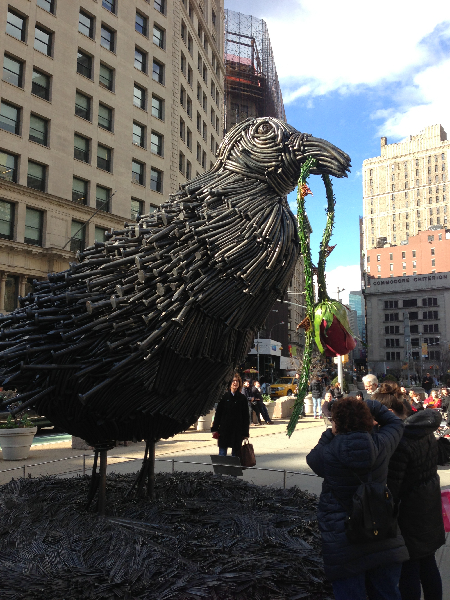I hope I can find the words to describe “The Testament of Mary,” with Fiona Shaw. She has no trouble with words, in a flawless, pointed, energized, painful one-woman play by Colm Toibin. I read the book when it came out a few months ago, and the book seems to be a transcript of the play. While I enjoyed it, the play and Shaw’s performance has left me dizzy with awe, exhaustion, and reverence.
The subject is irreverent–positioning Mary as a truth teller about what really happened during Jesus’ last days and the rewriting of religious history. The play may have one of the best last lines in all of theater history.
The experience of the play started the moment I arrived, about 15 minutes early. Shaw was walking out on stage, and people were milling about on stage. “Are those audience members?” I asked the usher by the stage. I was invited to join them and did.
By then, Shaw was seated, wrapped in a blue blanket like a shawl over her head and most of her body, over a corral dress. She was holding an apple in one hand and three lilies in the other. Her gaze was heavenward, and her lips moved, as if in prayer.
As gorgeous as any Raphael Mary, still as any sumptuous still life, Shaw was pedestaled for display. She sat in a glass box, covered with a gauzy, black scrim. The audience meandered around her and around the stage, most stopping in front of the vulture chained to a three legged, wooden table. The huge black bird with its bare blue head and pinkish purple beak occasionally would extend its wings to full span, revealing the white under-feathers. Twice, it freaked out, and a handler calmed it.
The stage was strewn with detritus, both vaguely historical and vaguely modern. Handwritten notes, a dirty coffee cup, and an old tape recorder were on one folding, metal chair, next to hip high earthenware jugs. A ladder, some wire, a birdcage, some herbs in a basket with gloves, a tub, all were scattered around the stage, a messy counterpoint to the perfect beauty of Mary as presented to us through the ages.
In the back, a tree with a wheel horizontally affixed to the top added creepiness to the staged world that didn’t quite cohere. Nearby, the stage floor had a glass window. Looking way down, like into an archeological dig, were more earthenware jugs, some broken, and a bare mattress. The audience couldn’t see this hidden room, unless they came on stage.
Synthesizer music played all the while. Then as Shaw stood up, the black sheer curtains fell around her, and the glass box lifted to the rafters. She removed the blue and coral garments to reveal a plain gray tunic over taupe pants and brown boots. She revealed the Mary the audience would encounter.
She put on the glove, took the vulture onto it, unchained and took it offstage. The stage went dark. The synthesizer music softened. Running water was heard. The play began.





































 The work is magnificent, but I loved some of the others as much, if not more. “Jewel” and “Incision” are mesmerizing.
The work is magnificent, but I loved some of the others as much, if not more. “Jewel” and “Incision” are mesmerizing. ghtful to be sure, hearing her sing Julie Jordan, I didn’t know she had that kind of voice in her. Every time she opened her mouth, tears rand down my cheeks. Nathan Gunn is a huge baritone, spoken and singing, and his Billy, well it’s a match for her Julie.
ghtful to be sure, hearing her sing Julie Jordan, I didn’t know she had that kind of voice in her. Every time she opened her mouth, tears rand down my cheeks. Nathan Gunn is a huge baritone, spoken and singing, and his Billy, well it’s a match for her Julie. Stephanie Blythe will never be accused of acting, but hearing her sing “You’ll Never Walk Alone” with the walls trembling is noble.
Stephanie Blythe will never be accused of acting, but hearing her sing “You’ll Never Walk Alone” with the walls trembling is noble. Although I really shouldn’t be surprised. From what I can tell, even the divine Tiler Peck, from the New York City Ballet, can sing, and her second act ballet? She’s a gorgeous being. Only John Cullum appears to have no voice, but he was so perfect in the role of Dr. Seldon. Kate Burton took the throwaway role of Mrs. Mulin, maybe just to be in the company of this company!
Although I really shouldn’t be surprised. From what I can tell, even the divine Tiler Peck, from the New York City Ballet, can sing, and her second act ballet? She’s a gorgeous being. Only John Cullum appears to have no voice, but he was so perfect in the role of Dr. Seldon. Kate Burton took the throwaway role of Mrs. Mulin, maybe just to be in the company of this company!

